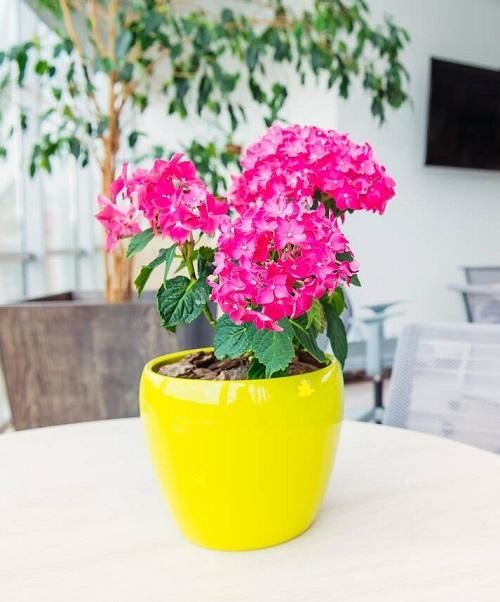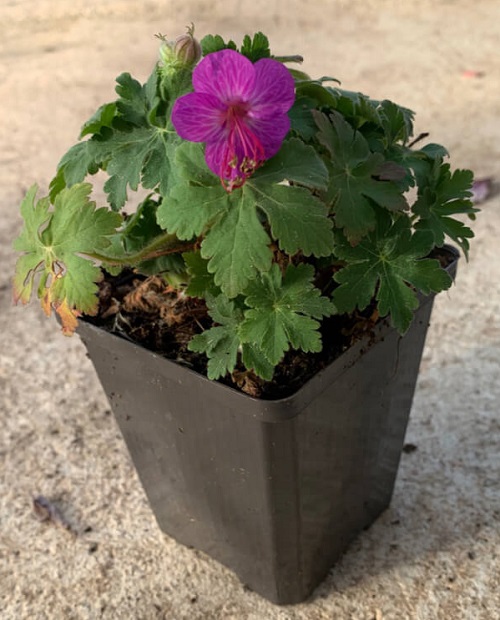With fragrant leaves, showy blossoms, and a compact growth habit, Bigroot Geranium will fill your home with happy vibes!

Native to Southern Europe, Bigroot Geranium is widely loved for its fragrant foliage, stunning flowers, and versatility to thrive as both indoor and outdoor specimens. Learn everything about Growing Bigroot Geranium Indoors with this extensive care guide!
- Botanical Name: Geranium macrorrhizum
- Popular as—Balkan Cranesbill, Bigroot Geranium, and Rock Crane’s-Bill
- Requires bright sunlight to produce fuller blooms
- Thrives in a temperature range of 65-80°F (18-26°C)
- Mildly toxic to pets.
Learn about the Flowers that Grow Without Soil here
What is Bigroot Geranium?
Member of the Geraniaceae family, Bigroot Geranium flaunts a dense mat of deep green, palmate leaves that exude a strong aroma when touched, often described as a mix of spicy and minty scents. Clusters of vibrant blooms adorn the plant in late spring and early summer with shades of pink, purple, or white, each measuring about 1 inch in diameter.
Apart from its ornamental beauty, the plant also offers various medicinal properties. Historically, it has been used to treat ailments like inflammation and hemorrhoids thanks to its anti-inflammatory and astringent qualities.
With a decent height of 1-2 feet, extraordinary appearance, and ready maintenance, the Bigroot Geranium makes for a beautiful potted specimen for a windowsill garden or basking in a sunny patch in the living.
Is Bigroot Geranium a Perennial?
Yes, Bigroot Geranium is a perennial plant—it will return year after year when provided with the proper growing conditions. In regions with milder winters, the plant’s foliage may remain evergreen throughout the year, whereas in colder climates, it may die back but will regrow in the spring. This hardy perennial can offer years of beauty and enjoyment when properly cared for, making it a valuable addition to your indoor garden.
Look at the Best Red Flowering Succulents here
Is Bigroot Geranium Invasive?
Bigroot Geranium is not considered invasive in most parts of the United States. While it is a vigorous grower with the ability to spread, it does not typically exhibit aggressive or invasive behavior. As an indoor plant enthusiast, you need not worry about the plant’s growth rate, as that can easily be managed by repotting or dividing when necessary.
However, you must keep an eye on its growth, ensuring that it doesn’t encroach on other plants’ space or overwhelm native species.
Bigroot Geranium Varieties

There are several notable varieties of Bigroot Geranium, each with its own unique characteristics, making for attractive houseplant options. Some of the most popular varieties include:
- Geranium macrorrhizum ‘Bevan’s Variety’: Known for its striking magenta flowers, robust growth habit, and deeply lobed, aromatic foliage that turns a beautiful bronze shade in the fall.
- Geranium macrorrhizum ‘Czakor’: Features stunning dark pink flowers and attractive semi-evergreen leaves.
- Geranium macrorrhizum ‘Ingwersen’s: Prized for its pale pink flowers, vigorous growth habit, and aromatic foliage exhibiting a softer green shade compared to other varieties.
- Geranium macrorrhizum ‘Spessart’: Loved for its pure white flowers with delicate pink veins, which create a beautiful contrast against the deep green foliage.
- Geranium macrorrhizum ‘White-Ness’: Features pristine white flowers and a compact growth habit amidst fragrant, semi-evergreen foliage.
- Geranium macrorrhizum ‘Album’: Produces pristine white flowers atop deep green foliage that emits a pleasant, spicy scent.
- Geranium macrorrhizum ‘Cannon’s Double’: Features semi-double, rose-pink flowers, besides highly aromatic, dark green foliage.
- Geranium macrorrhizum ‘Variegatum’: Stands out for its variegated leaves with irregular white margins, creating a striking contrast against its pink flowers.
- Geranium macrorrhizum ‘Lohfelden’: Boasts lavender-pink flowers and a compact growth habit, perfect for container gardens and smaller indoor spaces.
- Geranium macrorrhizum ‘Pindus’: Blooms pale pink flowers with darker pink veins amidst deep green foliage that takes on a reddish hue in the fall.
Find some Stunning Burgundy Houseplants here
Ideal Pot Size
Finding the ideal pot size for a houseplant depends on the size of the plant’s root ball. A 6-8 inches pot will suffice for a young Bigroot Geranium, allowing the plant ample room to grow and establish its root system.
As the plant matures and spreads, you may transfer it to a one-size bigger container to prevent overcrowding and ensure optimal growth.
Bigroot Geranium Propagation

Propagating Bigroot Geranium at home is relatively simple, and there are two primary methods: Division and Stem Cuttings. All you need are—a healthy, disease-free plant, a sterile clipper, and some well-draining potting mix.
Division:
- Gently remove the parent plant from its pot in spring or early fall.
- Using a clean, sharp knife or garden shears, divide the root ball into sections, each containing a healthy portion of roots and foliage.
- Plant each division into separate pots filled with well-draining potting mix.
- Water the divisions thoroughly and place them in a location with bright, indirect light.
Stem Cuttings:
- Take 3-4 inch stem cuttings from the parent plant, ensuring each cutting has at least one leaf node.
- Remove the lower leaves, leaving only the topmost leaves.
- Dip the cut end of each cutting into rooting hormone powder to promote root development.
- Plant the cuttings in small pots filled with a well-draining potting mix, burying the nodes 1-2 inches deep.
- Water the cuttings thoroughly and cover the pots with clear plastic bags or place them in an indoor greenhouse to maintain high humidity.
- Place the cuttings in a location with bright, indirect light and ensure the soil remains consistently moist but not waterlogged.
After 4-6 weeks, new growth will appear. You may cut back on watering once the plant reaches a considerable height and provide it with a suitable growing environment.
Look at the Best Orange Flowering Succulents here
Bigroot Geranium Care

Light
Bigroot Geraniums require bright sunlight to produce fuller blooms. Place it near the west or south-facing window to provide the same. However, if you notice the leaf edges turning brown or crisp, move it to the northern windows or filter the sunlight with a curtain.
Do remember that the plant will bloom with little to no flowers in absolute shade, so keep grow lights handy in case your home doesn’t receive direct sunlight at all.
Soil
The perennial prefers a well-draining soil mix that retains moisture without becoming waterlogged. Go for a high-quality potting mix amended with a fistful of perlite, vermiculite, or coarse sand to boost drainage. The plant is not overly fussy about soil pH, but it generally prefers a slightly acidic to neutral pH range of 6.0-7.0.
Water
Bigroot Geranium requires consistent moisture for optimal growth. Water the plant when the top 1-2 inches of soil feels dry to the touch. Follow a weekly deep watering session by saturating the medium until water drains out of the drainage holes and letting the medium dry out a little before repeating again.
This will ensure that you don’t end up overwatering while meeting the plant’s moisture requirements. Reduce the watering frequency during the plant’s dormancy in the colder months to avoid plant shock.
Temperature & Humidity
Geranium macrorrhizum prefers moderate indoor temperatures, ideally between 65-80°F (18-26°C) during the day and slightly cooler temperatures at night. It can tolerate brief temperature fluctuations, but prolonged exposure to extreme temperatures can stress the plant.
The plant is relatively adaptable and can tolerate average indoor humidity levels. However, if your indoor environment is exceptionally dry, consider using a humidifier or placing a tray of water near the plant to increase the moisture levels in the air.
Fertilizer
Feed your Bigroot Geranium with a balanced, water-soluble fertilizer, such as a 10-10-10 or 20-20-20 formulation, diluted to half strength, every 4-6 weeks during spring and summer to encourage robust growth and blooming.
Avoid over-fertilizing, as this will lead to excessive growth and potential nutrient imbalances. Keep from feeding the plant in the colder months when it enters a period of dormancy.
Pruning
Pruning is essential for maintaining a healthy and attractive Bigroot Geranium. Remove any dead or yellowing leaves to promote airflow and prevent diseases. Also, ensure to prune back the spent flower stems to encourage a more compact growth habit and stimulate new growth.
If your geranium becomes too large or overgrown, trim back the foliage by about one-third to maintain a more manageable size. Always use sharp, sterile pruning shears or scissors to make clean cuts and minimize the risk of disease transmission.
Common Troubleshooting Tips
Keep an eye on the potential issues that may arise while Growing Bigroot Geranium Indoors. Find some common problems and their solutions below!
- Yellowing leaves: Maintain proper moisture balance in the medium and do not let it get overly wet or dry. Allow the top 1-2 inches of soil to dry out between waterings.
- Leggy growth: Move the plant to a location with brighter, indirect light. Avoid placing it in direct sunlight, which can scorch the leaves.
- Leaf scorch or Browning: Relocate the plant to an area with filtered or indirect light to prevent further damage.
- Failure to Bloom: Ensure the plant receives enough bright, indirect light to encourage flowering. Reduce the frequency and strength of fertilization to avoid excessive growth at the expense of flowering.
- Pests: Inspect the plant regularly for pests such as aphids, mealybugs, or spider mites and treat the affected areas with insecticidal soap, neem oil, or horticultural oil spray. Isolate the affected plant to prevent the spread of pests to other plants.
- Root Rot: Improve the soil mix’s drainage by adding perlite, vermiculite, or coarse sand. Ensure the pot has drainage holes and avoid overwatering.
- Powdery Mildew or Other Fungal Diseases: Prune the plant to remove dead or crowded growth and maintain adequate spacing between plants to improve air circulation. Avoid misting the plant and reduce humidity levels if necessary.
Where to Buy Bigroot Geranium?
When searching for a place to purchase Bigroot Geranium, consider reputable online retailers, local garden centers, and nurseries. Several well-established online retailers offer Bigroot Geranium for Sale and provide detailed plant descriptions, care instructions, and customer reviews, ensuring that you make an informed decision before purchasing.
Local garden centers and nurseries are also great places to look for. These establishments often provide expert advice on plant care, as well as recommendations on which varieties would work best in your specific garden conditions. By purchasing from a local source, you can ensure that you receive healthy plants acclimated to your region’s climate.






